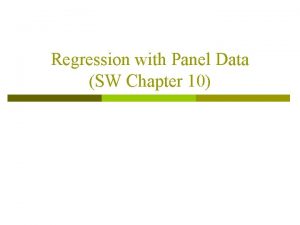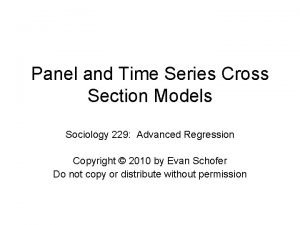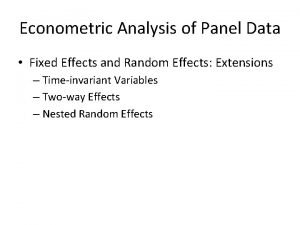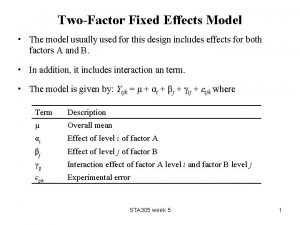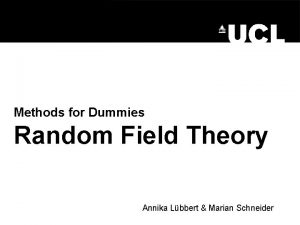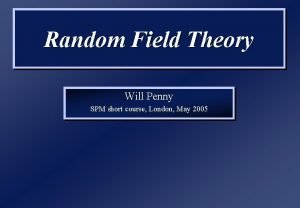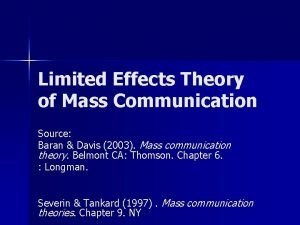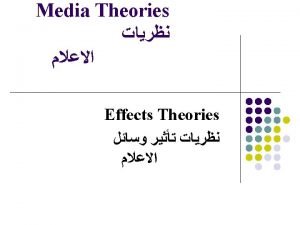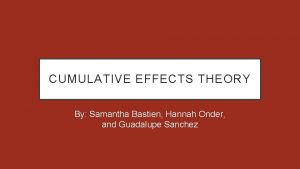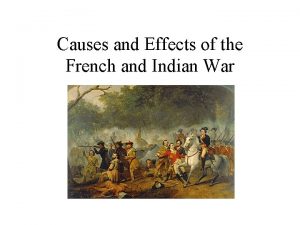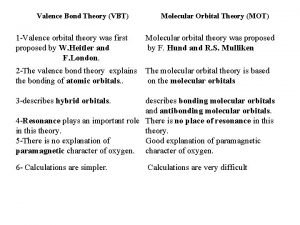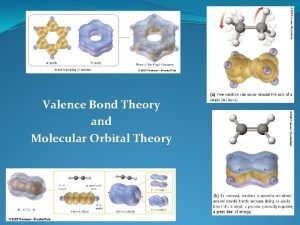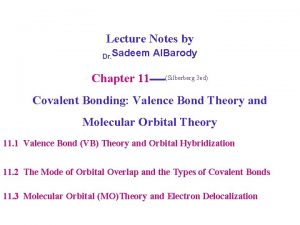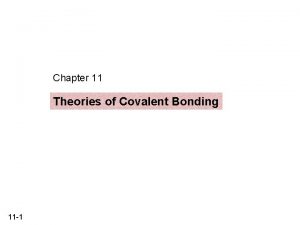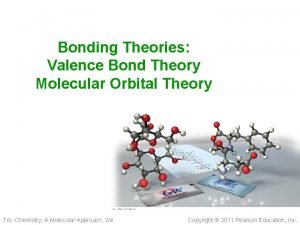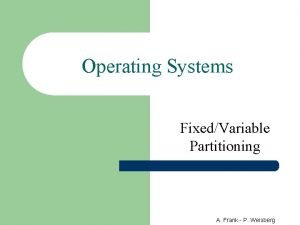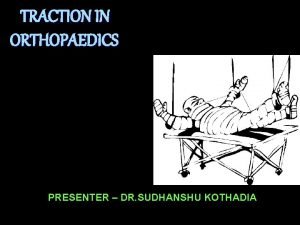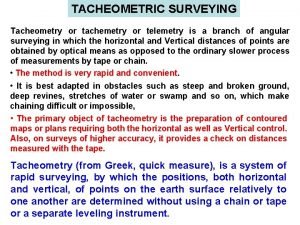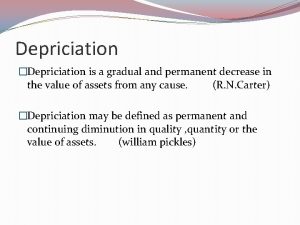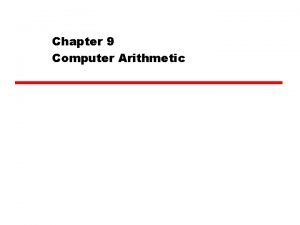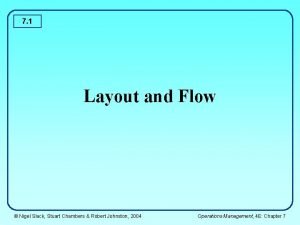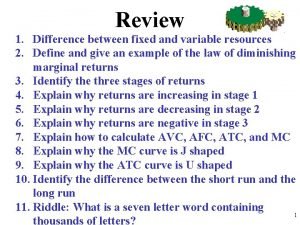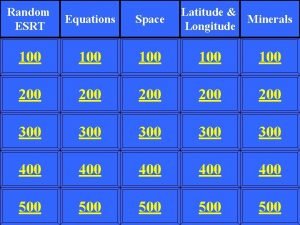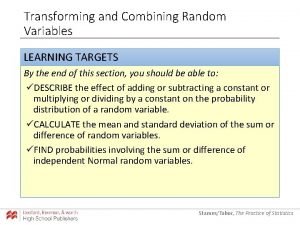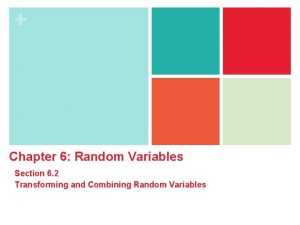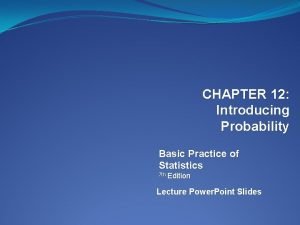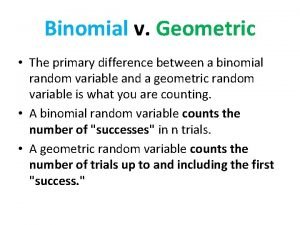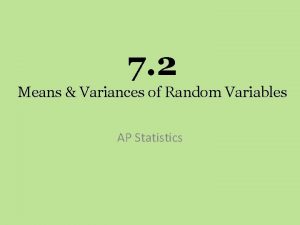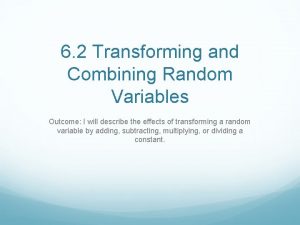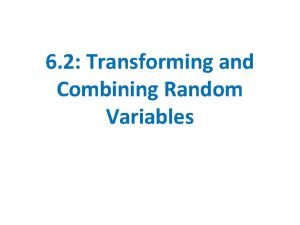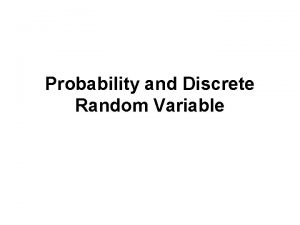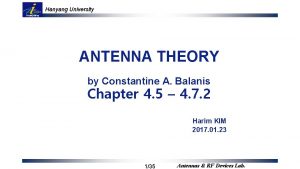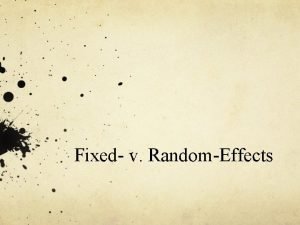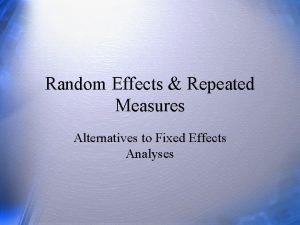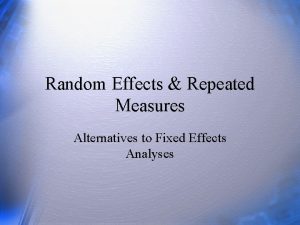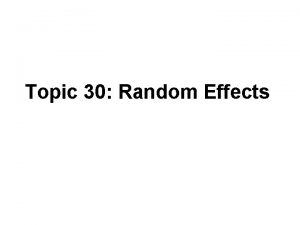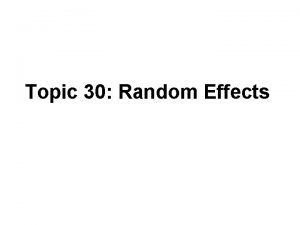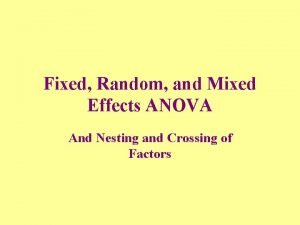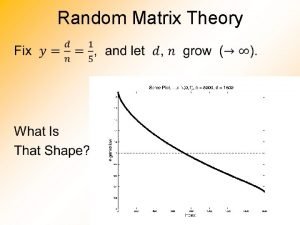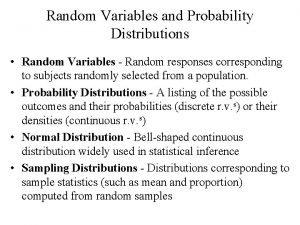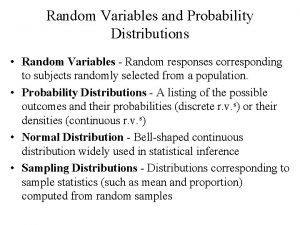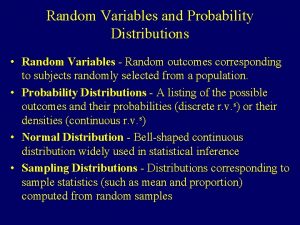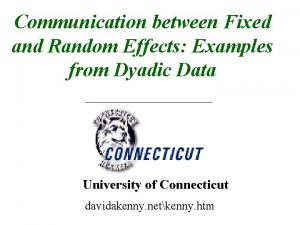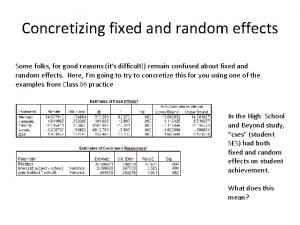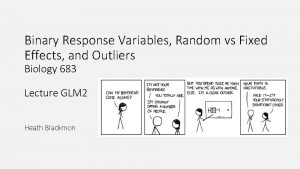Fixed and Random Effects Theory of Analysis of










![Multiple t-Test sed[x] = (2 2/n) (2 x 94, 773/4) |XA - XB|/sed[x] >= Multiple t-Test sed[x] = (2 2/n) (2 x 94, 773/4) |XA - XB|/sed[x] >=](https://slidetodoc.com/presentation_image_h/ea87f94cb0120ba6a6377b81f5e6266e/image-11.jpg)
![Least Significant Difference |XA - XB|/sed[x] >= tp/2 LSD = tp/2 x sed[x] t Least Significant Difference |XA - XB|/sed[x] >= tp/2 LSD = tp/2 x sed[x] t](https://slidetodoc.com/presentation_image_h/ea87f94cb0120ba6a6377b81f5e6266e/image-12.jpg)





![Tukey’s Multiple Range Test W = q(p, f) x se[x] = ( 2/n) (94, Tukey’s Multiple Range Test W = q(p, f) x se[x] = ( 2/n) (94,](https://slidetodoc.com/presentation_image_h/ea87f94cb0120ba6a6377b81f5e6266e/image-18.jpg)












![Orthogonality ci = 0 [c 1 i x c 2 i] = 0 -1 Orthogonality ci = 0 [c 1 i x c 2 i] = 0 -1](https://slidetodoc.com/presentation_image_h/ea87f94cb0120ba6a6377b81f5e6266e/image-31.jpg)


![S. Sq = [ ci x Yi]/[n 2 ci ] S. Sq(1) [(-1)64. 1+(-1)76. S. Sq = [ ci x Yi]/[n 2 ci ] S. Sq(1) [(-1)64. 1+(-1)76.](https://slidetodoc.com/presentation_image_h/ea87f94cb0120ba6a6377b81f5e6266e/image-34.jpg)
![S. Sq(2) [(-1)x 64. 1+(+1) x 76. 6]2/(3 x 2) 26. 04 S. Sq(3) S. Sq(2) [(-1)x 64. 1+(+1) x 76. 6]2/(3 x 2) 26. 04 S. Sq(3)](https://slidetodoc.com/presentation_image_h/ea87f94cb0120ba6a6377b81f5e6266e/image-35.jpg)






![S. Sq(1)= [(-3)130+(-3)124+(2)141+(2)186+(2)119]2 /n ci 2 1302/(4 x 40) = 140. 8 S. Sq(2)= S. Sq(1)= [(-3)130+(-3)124+(2)141+(2)186+(2)119]2 /n ci 2 1302/(4 x 40) = 140. 8 S. Sq(2)=](https://slidetodoc.com/presentation_image_h/ea87f94cb0120ba6a6377b81f5e6266e/image-42.jpg)




![S. Sq(1)= [(-3)130+(-3)124+(2)141+(2)186+(2)119]2 /n ci 2 1302/(4 x 40) = 140. 8 S. Sq(2)= S. Sq(1)= [(-3)130+(-3)124+(2)141+(2)186+(2)119]2 /n ci 2 1302/(4 x 40) = 140. 8 S. Sq(2)=](https://slidetodoc.com/presentation_image_h/ea87f94cb0120ba6a6377b81f5e6266e/image-47.jpg)



































- Slides: 82

Fixed and Random Effects

Theory of Analysis of Variance Source of variation df EMS Between treatments n-1 e 2 + k t 2 Within treatments Total nk-n e 2 nk-1 [ e 2 + k t 2]/ e 2 = 1, if k t 2 = 0

Setting Expected Mean Squares v The expected mean square for a source of variation (say X) contains. v the error term. v a term in 2 x. v a variance term for other selected interactions involving X.

Coefficients for EMS Coefficient for error mean square is always 1 Coefficient of other expected mean squares is # reps times the product of factors levels that do not appear in the factor name.

Expected Mean Squares v. Which interactions to include in an EMS? v. All the factors appear in the interaction. v. All the other factors in the interaction are Random Effects.

Pooling Sums of Squares

Multiple Comparisons

Multiple Comparisons v. Multiple Range Tests: Øt-tests and LSD’s; ØTukey’s and Duncan’s. v. Orthogonal Contrasts.

One-way Analysis of Variance

Means and Rankings
![Multiple tTest sedx 2 2n 2 x 94 7734 XA XBsedx Multiple t-Test sed[x] = (2 2/n) (2 x 94, 773/4) |XA - XB|/sed[x] >=](https://slidetodoc.com/presentation_image_h/ea87f94cb0120ba6a6377b81f5e6266e/image-11.jpg)
Multiple t-Test sed[x] = (2 2/n) (2 x 94, 773/4) |XA - XB|/sed[x] >= tp/2
![Least Significant Difference XA XBsedx tp2 LSD tp2 x sedx t Least Significant Difference |XA - XB|/sed[x] >= tp/2 LSD = tp/2 x sed[x] t](https://slidetodoc.com/presentation_image_h/ea87f94cb0120ba6a6377b81f5e6266e/image-12.jpg)
Least Significant Difference |XA - XB|/sed[x] >= tp/2 LSD = tp/2 x sed[x] t 0. 025 = 2. 518 LSD = 2. 518 x 217. 7 = 548. 2

Least Significant Difference Say one of the cultivars (E) is a control check and we want to ask: are any of the others different from the check? LSD = 2. 518 x 217. 7 = 548. 2 XE + LSD 1796 + 548. 2 = 2342. 2 to 1247. 80

Means and Rankings Range = 1796 + 548. 2 = 2342. 2 to 1247. 80

Multiple LSD Comparisons

Lower Triangular Form

LSD Multiple Comparisons
![Tukeys Multiple Range Test W qp f x sex 2n 94 Tukey’s Multiple Range Test W = q(p, f) x se[x] = ( 2/n) (94,](https://slidetodoc.com/presentation_image_h/ea87f94cb0120ba6a6377b81f5e6266e/image-18.jpg)
Tukey’s Multiple Range Test W = q(p, f) x se[x] = ( 2/n) (94, 773/4) = 153. 9 W = 4. 64 x 153. 9 = 714. 1

Tukey’s Multiple Range Test

Tukey’s Multiple Comparisons

Duncan’s Multiple Range Test

Duncan’s Multiple Range Test

Duncan’s Multiple Range Test

Duncan’s Multiple Range Test

Duncan’s Multiple Comparisons

Orthogonal Contrasts

AOV Orthogonal Contrasts

Tukey’s Multiple Range Test

Consider that cultivars A and B were developed in Idaho and C and D developed in California v Do the two Idaho cultivars have the same yield potential? v Do the two California cultivars have the same yield potential? v Are Idaho cultivars higher yielding than California cultivars?

Analysis of Variance
![Orthogonality ci 0 c 1 i x c 2 i 0 1 Orthogonality ci = 0 [c 1 i x c 2 i] = 0 -1](https://slidetodoc.com/presentation_image_h/ea87f94cb0120ba6a6377b81f5e6266e/image-31.jpg)
Orthogonality ci = 0 [c 1 i x c 2 i] = 0 -1 -1 +1 +1 -- ci = 0 -1 +1 -- ci = 0 +1 -1 -1 +1 -- ci = 0

Calculating Orthogonal Contrasts d. f. (single contrast) = 1 S. Sq(contrast) = M. Sq = [ ci x Yi]2/n ci 2]

Orthogonal Contrasts - Example
![S Sq ci x Yin 2 ci S Sq1 164 1176 S. Sq = [ ci x Yi]/[n 2 ci ] S. Sq(1) [(-1)64. 1+(-1)76.](https://slidetodoc.com/presentation_image_h/ea87f94cb0120ba6a6377b81f5e6266e/image-34.jpg)
S. Sq = [ ci x Yi]/[n 2 ci ] S. Sq(1) [(-1)64. 1+(-1)76. 6+(1)40. 1+(1)47. 8]2/ n ci 2 = 52. 82/(3 x 4) = 232. 32
![S Sq2 1x 64 11 x 76 623 x 2 26 04 S Sq3 S. Sq(2) [(-1)x 64. 1+(+1) x 76. 6]2/(3 x 2) 26. 04 S. Sq(3)](https://slidetodoc.com/presentation_image_h/ea87f94cb0120ba6a6377b81f5e6266e/image-35.jpg)
S. Sq(2) [(-1)x 64. 1+(+1) x 76. 6]2/(3 x 2) 26. 04 S. Sq(3) [(-1)x 40. 1+(+1) x 47. 8]2/(3 x 2) 9. 88

Orthogonal Contrasts

Orthogonal Contrasts v Five dry bean cultivars (A, B, C, D, and E). v Cultivars A and B are drought susceptible. v Cultivars C, D and E are drought resistant. v Four Replicate RCB, one location v Limited irrigation applied.

Analysis of Variance

Orthogonal Contrast Example #2 Tukey’s Multiple Range Test

Orthogonal Contrasts v Is there any difference in yield potential between drought resistant and susceptible cultivars? v Is there any difference in yield potential between the two drought susceptible cultivars? v Are there any differences in yield potential between the three drought resistant cultivars?

Orthogonal Contrasts
![S Sq1 313031242141218621192 n ci 2 13024 x 40 140 8 S Sq2 S. Sq(1)= [(-3)130+(-3)124+(2)141+(2)186+(2)119]2 /n ci 2 1302/(4 x 40) = 140. 8 S. Sq(2)=](https://slidetodoc.com/presentation_image_h/ea87f94cb0120ba6a6377b81f5e6266e/image-42.jpg)
S. Sq(1)= [(-3)130+(-3)124+(2)141+(2)186+(2)119]2 /n ci 2 1302/(4 x 40) = 140. 8 S. Sq(2)= [(-1)130+(+1)124]2 /n ci 2 62/(4 x 2) = 4. 5 S. Sq(Rem) = S. Sq(Cult)-S. Sq(1)-S. Sq(2) 728. 2 -140. 8 -4. 5 = 582. 9 (with 2 d. f. )

Analysis of Variance

Partition Contrast(rem)

Analysis of Variance

Alternative Contrasts !!!!
![S Sq1 313031242141218621192 n ci 2 13024 x 40 140 8 S Sq2 S. Sq(1)= [(-3)130+(-3)124+(2)141+(2)186+(2)119]2 /n ci 2 1302/(4 x 40) = 140. 8 S. Sq(2)=](https://slidetodoc.com/presentation_image_h/ea87f94cb0120ba6a6377b81f5e6266e/image-47.jpg)
S. Sq(1)= [(-3)130+(-3)124+(2)141+(2)186+(2)119]2 /n ci 2 1302/(4 x 40) = 140. 8 S. Sq(2)= [(-1)130+(-1)124+(-1)141+(4)186+(-1)119]2 /n ci 2 2302/(4 x 20) = 661. 2 S. Sq(Rem) = S. Sq(Cult)-S. Sq(1)-S. Sq(2) 728. 2 -140. 8 -661. 2 = -73. 8 (Oops !!!) (with 2 d. f. )

Orthogonality c 1 i = 0 ( c 2 i = 0 ( [c 1 i x c 2 i] = 0 (- -3) + (+2) = 0 = -1) + (-1) + (+4) + (-1) = 0 = 3)(-1)+(-3)(-1)+2(4)+2(-1) =10 =

More Appropriate Contrasts

Analysis of Variance

Conclusions v Almost all the variation between cultivars is accounted for by the difference between cv ‘D’ and the others. v The remaining 4 cultivars are not significantly different. v Orthogonal contrast result is exactly the same are the result from Tukey’s contrasts.

Conclusions v Important to make the “correct” orthogonal contrasts. v Important to make contrasts which have “biological sense”. v Orthogonal contrasts should be decided prior to analyses and not dependant on the data.

Orthogonal Contrasts v Four Brassica species (B. napus, B. rapa, B. juncea, and S. alba). v Ten cultivars ‘nested’ within each species. v Three insecticide treatments (Thiodan, Furidan, no insecticide). v Three replicate split-plot design.

Analysis of Variance

Species and Treatment Means

Orthogonal Contrasts

Orthogonal Contrasts

Analysis of Variance

Species x Treatment Interaction

Species x Contrast (1)

Species x Contrast (2)

More Orthogonal Contrasts … Trend Analyses

Aim of Analyses of Variance v Detect significant differences between treatment means. v Determine trends that may exist as a result of varying specific factor levels.

Example #4 v Ten yellow mustard (S. alba) cultivars. v Five different nitrogen application rates (50, 75, 100, 125, and 150)

Analysis of Variance

Orthogonal Contrasts

Example #4

Example #4

Example #4

Analysis of Variance

Trend Analyses v. The F-value associates with a trend contrast is significant. v. All higher order trend contrasts are not significant.

Example #4

Linear

Quadratic

Cubic

Quartic

Example #5 v. Two carrot cultivars (‘Orange Gold’ and ‘Bugs Delight’. v. Four seeding rates (1. 5, 2. 0, 2. 5 and 3. 0 lb/acre). v. Three replicates.

Example #5

Analysis of Variance

Analysis of Variance

Analysis of Variance Orange Gold Bug’s Delight

End of Analyses of Variance Section
 Fixed function ic package
Fixed function ic package Continuous reinforcement
Continuous reinforcement Primary vs secondary reinforcers
Primary vs secondary reinforcers Fixed interval vs variable interval
Fixed interval vs variable interval Fixed order quantity vs fixed time period
Fixed order quantity vs fixed time period Random assignment vs random sampling
Random assignment vs random sampling Random assignment vs random selection
Random assignment vs random selection Time fixed effects
Time fixed effects Panel regression
Panel regression Advanced regression models
Advanced regression models Time fixed effects
Time fixed effects Fixed effects model
Fixed effects model Random field theory
Random field theory Random field theory
Random field theory How to calculate predetermined overhead rate
How to calculate predetermined overhead rate Powerful effects theory
Powerful effects theory Powerful effects theory
Powerful effects theory What are the elements of mass communication
What are the elements of mass communication Powerful effects theory
Powerful effects theory Cumulative effects theory
Cumulative effects theory Causes and effects of the french and indian war
Causes and effects of the french and indian war Trait approaches to leadership
Trait approaches to leadership Continental drift vs plate tectonics
Continental drift vs plate tectonics Continental drift vs plate tectonics
Continental drift vs plate tectonics Difference between classical theory and neoclassical theory
Difference between classical theory and neoclassical theory Theory x and theory y of motivation
Theory x and theory y of motivation Hawthorne motivation theory
Hawthorne motivation theory Adjusted retention time
Adjusted retention time Title theory and lien theory
Title theory and lien theory Y management theory
Y management theory Game theory and graph theory
Game theory and graph theory Compare vbt and mot
Compare vbt and mot Valence bond theory and molecular orbital theory
Valence bond theory and molecular orbital theory Theory x and theory y
Theory x and theory y Valence bond theory and molecular orbital theory
Valence bond theory and molecular orbital theory Valence bond theory and molecular orbital theory
Valence bond theory and molecular orbital theory Valence bond theory
Valence bond theory Douglas mcgregor theory
Douglas mcgregor theory Fixed capital and working capital
Fixed capital and working capital Variable partition in os
Variable partition in os Characteristics of fixed position layout
Characteristics of fixed position layout Fixed investment and inventory investment
Fixed investment and inventory investment Fixed and sliding traction
Fixed and sliding traction Staff intercept formula
Staff intercept formula What is uses of pulley
What is uses of pulley Emulsion identification test
Emulsion identification test Dry gum method ratio
Dry gum method ratio Pzmax
Pzmax Shear force
Shear force Variable resources definition
Variable resources definition Fixed installment method
Fixed installment method Computer arithmetic
Computer arithmetic Fixed position layout example
Fixed position layout example Variable resources definition
Variable resources definition Plasma panel display in computer graphics
Plasma panel display in computer graphics Random latitude and longitude
Random latitude and longitude Random and raster scan display in computer graphics
Random and raster scan display in computer graphics What is random file organisation
What is random file organisation Random error
Random error Combining random variables
Combining random variables Simple random sampling pros and cons
Simple random sampling pros and cons Absolute error and relative error
Absolute error and relative error Transforming and combining random variables
Transforming and combining random variables In probability and statistics a random phenomenon is
In probability and statistics a random phenomenon is How to tell if binomial or geometric
How to tell if binomial or geometric Rules for means and variances
Rules for means and variances Combining random variables
Combining random variables Advantages and disadvantages of systematic sampling
Advantages and disadvantages of systematic sampling Fast random walk with restart and its applications
Fast random walk with restart and its applications Loser buys the pizza leona and fred
Loser buys the pizza leona and fred Random variable
Random variable Finite length dipole antenna
Finite length dipole antenna Primary and secondary effects of a tectonic hazard
Primary and secondary effects of a tectonic hazard Pinotubo
Pinotubo Steering axis inclination angle
Steering axis inclination angle Causes and effects of the russian revolution
Causes and effects of the russian revolution Causes and effects of french revolution
Causes and effects of french revolution Effects of the cotton gin
Effects of the cotton gin Causes and effects of the french revolution
Causes and effects of the french revolution Causes and effects of french revolution
Causes and effects of french revolution Positive and negative effects of television
Positive and negative effects of television Cold war summary
Cold war summary Strengths of the continental army
Strengths of the continental army







